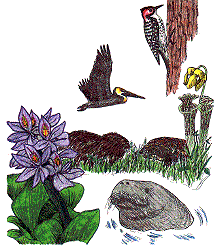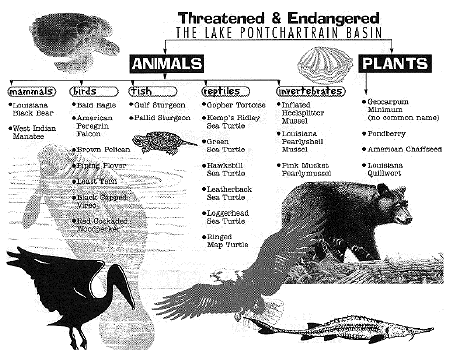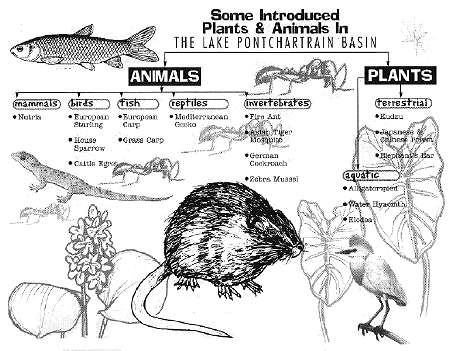
|
Ecosystems in Delicate Balance: Threatened, Endangered, and Introduced Species of the Lake Pontchartrain Basin
- An ecosystem can be thought of as a natural unit (e.g., wetlands, pine forests, or the entire Lake Pontchartrain Basin) consisting of living and non-living parts which interact to form a stable system. Examples of living and non-living parts include plants, animals, soil chemistry, temperature, nutrient supply, etc.
- Ecosystems in their natural state are finely-tuned and well-balanced.
- Ecosystems support and depend upon a tremendous diversity of plants and animals.
- Large numbers of animals and plants in the ecosystem indicate higher levels of biodiversity and greater complexity.
Biodiversity
Imagine the ecosystem as a tiny city, bustling with "people". This city has a tremendous number of important jobs which need to be carried out all day long, every day. Plants convert sunlight to energy; insects convert plant matter to energy; other animals eat insects and each other; decomposers, rippers and shredders tear everything down to make room and nutrients for new plants and animals... All of these jobs need to be taken care of by someone...BIODIVERSITY means that there are many different kinds of organisms available for employment at any given time...
- The Sun provides energy to Producers (green plants and algae, etc.).
- Producers provide energy to Primary Consumers (herbivores, or organisms that eat only plants).
- Primary Consumers provide energy to Secondary Consumers (carnivores, animals that eat herbivores, or omnivores, that eat both plants and animals).
- Secondary Consumers provide energy to Tertiary Consumers (carnivores and scavengers who occupy the tops of their respective food chains, like eagles or humans).
- Decomposers are microorganisms like bacteria and fungi which cause a breakdown of dead organic tissues (plants and animals), releasing their stored nutrients for re-use.
- Nutrients released by decomposers are re-used by producers, starting the cycle over.
- A certain amount of energy is lost in each stage of the food chain. This effectively limits the overall length of any given food chain. In other words, at some point, the energy spent getting food is greater than the energy gained from the food source, so an animal becomes weaker and weaker as time goes on until death finally occurs.
|
Increased biodiversity provides a more stable ecosystem because responsibility for various "jobs" are shared.
|
|---|
- When humans interfere with delicate ecosystems, the most common result is severe disruption of natural balances which, in turn, results in greatly reduced ecosystem function.
- When agricultural runoff and sewer discharges (unnaturally high levels of fertilizer) are emptied into Lake Pontchartrain, a dramatic increase in algal growth can be the result. This, in turn, results in turbid or cloudy water; aquatic plants die because they can't get the same levels of sunlight, and algae blooms deplete aquatic systems of necessary oxygen.
- As aquatic plants die, small fish which depend upon these plants also begin to die. In turn, larger fish which depend upon the smaller fish also die or leave. This represents the beginning of ecosystem collapse.
All is not lost, however!!
Much of the damage we inflict upon the world around us can be lessened or even reversed if we pay attention to the little changes in our ecosystems. Each of us can contribute by reducing the amount of runoff which enters the Lake Pontchartrain Basin and educating others about the importance of maintaining balanced ecosystems.
"Think Globally, Act Locally."
This often-quoted expression reminds us that, although our problems are global in nature, we need look only as far as our front door to find an ecosystem like Lake Pontchartrain that needs our help. It also serves to reinforce the idea that by working for better and more balanced ecosystems right here, we can ultimately affect the health of more distant ecosystems.
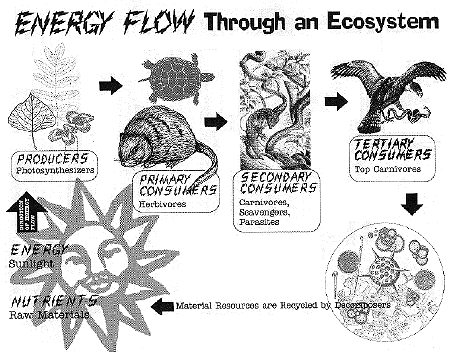
Click the illusration for a larger view.
Healthy vs. Unhealthy Ecosystems

- Each step in the FOOD CHAIN contains appropriate numbers of organisms
- For example, there is normally a correct proportion of nutrients & sunlight to support the PROPER BALANCE of algae plants
- When the proportions are CONSTANT, each group efficiently feeds from the next lower group and the chain RECYCLES itself continuously
- The cycle is maintained in a BALANCED SITUATION and is unlikely to change without some form of outside intervention such as geological, meteorological, human induced, etc.
|
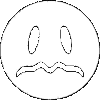
- If one group becomes too numerous, the chain becomes UNBALANCED
- For example, agricultural runoff creates a SURPLUS of nutrients which can cause sudden INCREASES in algae growth
- Too much algae blocks sunlight from reaching vascular plants
- Too few plants means LESS FOOD for herbivores
- Less herbivores means LESS FOOD for primary consumers, etc.
- As the chain becomes more & more UNBALANCED, the likelihood of ECOSYSTEM COLLAPSE is increased
|
|

